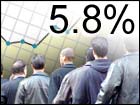|
U.S. unemployment rises
|
 |
January 4, 2002: 4:20 p.m. ET
Employers cut thousands more jobs, though not as many as in November.
|
NEW YORK (CNN/Money) - The U.S. unemployment rate rose to 5.8 percent in December, but the number of job cuts slacked off, pointing to a possible stabilization in the labor market of the world's largest economy.
The Labor Department said employers cut 124,000 jobs from non-farm payrolls last month after a revised loss of 371,000 jobs in November. The unemployment rate rose from a revised 5.6 percent. Economists surveyed by Briefing.com had forecast unemployment at 5.8 percent and job cuts of 155,000.
"Today's unemployment data were as expected, showing that we are still in a recession, but that the worst is behind us," Merrill Lynch chief economist Bruce Steinberg said.
U.S. stock prices rallied for a third straight session, while Treasury bond prices edged lower.
December brought the smallest drop in payrolls since August, but unemployment is the highest it's been since May 1995, and the number of job cuts is the highest since the 1990-91 recession. The Labor Department said the economy has shed 1.4 million jobs since March, when the National Bureau of Economic Research thinks another recession began.
To keep consumers spending despite mounting job cuts, the Federal Reserve cut its target for short-term interest rates 11 times in 2001.
Though unemployment likely will continue to rise in the near future, it's a lagging economic indicator, meaning it will rise even after the economy begins to recover, and many economists think the Fed will leave short-term rates alone at its next policy meeting, scheduled for Jan. 29-30.
"[Friday's report] probably reduces the odds of the Fed making another move [at its next meeting]," Bill Cheney, chief economist at John Hancock Financial Services, said. "This is fairly benign report; it would have taken something a bit worse than this to get the Fed to move again."
Even before the unemployment report, few economists expected another rate cut in January. Recent signs of stabilization in the labor market, consumer confidence and manufacturing, along with continuing strength in the housing market and low energy prices, have reinforced the consensus notion among economists that a recovery will begin in 2002.
And a separate report Friday showed growth in the U.S. service sector accelerated in December, reinforcing hopes of an imminent economic recovery.
In fact, though inflation is a distant threat now, Fed policy makers could be inclined to start raising rates again by the end of the year if they see signs the economy is recovering too rapidly.
"If unemployment sticks at about 6.0 percent and starts coming down, the Fed will probably feel it has to start tightening fairly soon," said Cheney, who thinks the Fed's target for the federal funds rate could rise from 1.75 percent to between 2.75 and 3.75 percent by the end of the year.
Click here for CNN/Money's economic calendar
As it has throughout the economic downturn, the manufacturing sector bore the brunt of the job cuts, dropping 133,000 jobs after losing 165,000 in November.
But job cuts in the retail sector increased to 77,000 from 12,000 in November, reflecting seasonal adjustments and the reluctance of retailers to add staff in what was expected to be a slow holiday season.
One surprise in the report was average hourly earnings, which rose 0.5 percent in December to $14.61 after a revised 0.5 percent gain in November. Economists surveyed by Briefing.com expected earnings to rise 0.3 percent.
The average workweek rose as well, to 34.2 hours from 34.1 hours in November. In manufacturing, the rise was somewhat more dramatic, increasing to 40.7 hours from 40.3 hours in November. And factory overtime increased to 3.9 hours from 3.7 hours in November, indicating a possible trend in the sector for 2002.
"When combined with the anticipated double-digit gains in employer health-care costs, manufacturers may find it very difficult to add to their payrolls next year and may opt to work their existing work forces longer," Wachovia Securities economist Mark Vitner said. 
|
|
|
|
|
|

|

